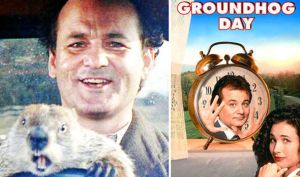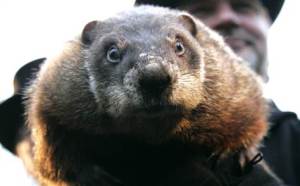Truth be told, if Thompson, Manitoba had a groundhog prognosticator when the sun rose several hours ago at 8:24 a.m. Central Standard Time (CST), he or she would very likely have predicted a short winter of only four more weeks because they probably wouldn’t have seen their shadow under mainly cloudy skies. Mind you, the groundhog would by lying. New arrivals to Thompson and environs are sometimes surprised their first year here to learn Feb. 2 really doesn’t have any resonance beyond wishful thinking. Winter ending in early or late March in Thompson? Six more weeks of winter only from Feb. 2?
Still, it could be worse. While Environment Canada again has us flagged under a red “Extreme Cold Warning” banner in its online weather forecast for Thompson today, the actual text of the bulletin helpfully notes, “The extreme wind chill has already abated for Thompson region but will likely redevelop tonight.” If you want to check out places with weather comparable to Thompson, you’d do well, says WeatherSpark, to check out of the Russian communities of Bayanday, (53°04′N latitude), and Mago (53° 15′ 05″ N latitude) in southeastern Siberia and central Asia, somewhere north of Ulaanbaatar, (Ulan Bator), the capital of Mongolia, another well-known world hotspot. Thompson is located at 55.7433° N latitude. WeatherSpark, was started by James Diebel, an American, and Jacob Norda, a Swede. Thompson’s fun weather facts are available online through their WeatherSpark website at: http://weatherspark.com/averages/28377/Thompson-Manitoba-Canada
Diebel, born and raised in Wisconsin, has a bachelor’s degree in engineering mechanics and astronautics, and mathematics from University of Wisconsin, and a PhD in aeronautics and astronautics from Stanford University, and Norda, born and raised in Sweden, holds a master’s degree in electrical engineering and applied physics from Linköping Institute of Technology. They teamed up and started Vector Magic, now known as Cedar Lake Ventures, Inc., in December 2007. Their weather facts are based on historical records dating back to 1988. Cedar Lake Ventures is located in the Minneapolis area in Excelsior, Minnesota. Diebel lives in the Minneapolis area, while Norda has lived in the San Francisco Bay Area since 2001.
While Thompson may well be in for another eight weeks or so of winter, whether it be under sunny or cloudy skies, Punxsutawney Phil, from Gobbler’s Knob in Punxsutawney, Pennsylvania, and Wiarton Willie from South Bruce County, Ontario, did their parts this morning to putting paid to polar and vanquishing the vortex elsewhere, first described as the polar vortex as early as 1853, by predicting an early spring. Punxsutawney Phil emerged from his burrow around 7:30 a.m. EST and did not see his shadow, predicting an early spring. “Faithful followers, there is no shadow of me and a beautiful spring it shall be,” a member of Phil’s Inner Circle read from the groundhog’s prediction scroll to the cheers and applause from the crowd. As the legend goes, if Phil sees his shadow, he considers it an “omen” of six more weeks of bad weather and heads back into his hole. If it’s cloudy and he doesn’t, you can put away that winter coat sooner than expected. Robert Buckle, mayor of the Town of South Bruce, which includes Wiarton, said Wiarton Willie had tweeted at 7:08 a.m. “So, my #prediction is #official. I didn’t see my shadow so an early spring it is.” (#officialprediction #earlyspring #WiartonWillie #Wiarton #PredictionMorning #GroundhogDay).
Rumour has it there were some groundhog dissenters to the early spring forecast, including Shubenacadie Sam. My one and only time covering a furry prognosticator came on Feb.2, 2000, when I was working for the Chronicle Herald’ s Truro bureau in Nova Scotia, and found myself that February morning assigned to go down to Shubenacadie, about 37 kilometres southwest of Truro in Hants County in central Nova Scotia, to cover the predictive prowess of Shubenacadie Sam, Nova Scotia’s most famous groundhog prognosticator. As well as Shubenacadie Sam, Punxsutawney Phil, and Wiarton Willie, other famous woodchuck prognosticators include (or have included), Manitoba’s own Winnipeg Willow, Manitoba Merv, and Winnipeg Wyn, who called for another six weeks of winter today after seeing her shadow.
In his 2002 book, The Day Niagara Falls Ran Dry, one of my favourites climatologists, David Phillips, cited a survey of 40 years of weather data from 13 Canadian cities, which concluded there was an equal number of cloudy and sunny days on Feb. 2 – and during that time, the groundhogs’ predictions were right only 37 per cent of the time. Sounds a bit like professional jealousy to me. While NOAA, the National Oceanic and Atmospheric Administration based in Washington, D.C. claims seven-day forecasts can now accurately predict the weather about 80 percent of the time and a five-day forecast can accurately predict the weather approximately 90 percent of the time, common sense tells us that can’t be true. Talk about fake news. We all know that the last day of a five or seven-day forecast is wildly hyped at the beginning of the period to be much nicer than it will turn out in reality when that day finally arrives five or seven days later. They hope, short-term memory being what it and all, that’s you’ll simply forget by day five or seven. If you don’t believe me, find out the truth for yourself by taking a look at the clip “Seven Day Forecast” from the Rick Mercer Report (https://www.cbc.ca/mercerreport/videos/clips/seven-day-forecast). In the past decade, Phil has predicted a longer winter seven times and an early spring three times. He was only right about 40 per cent of the time, according to the National Oceanic and Atmospheric Administration, which says the groundhog shows “no predictive skill” (https://www.ncdc.noaa.gov/customer-support/education-resources/groundhog-day).
Groundhog Day has its roots in the ancient Christian tradition of Candlemas Day, when clergy would bless and distribute candles needed for winter. The candles represented how long and cold the winter would be. Germans expanded on this concept by selecting an animal – the hedgehog – as a means of predicting weather. According to tradition, if a groundhog comes out of its burrow Feb. 2 – where the main entrance is often by a tree stump or rock and is usually conspicuous because of a pile of freshly excavated earth, with side entrances also and tunnels leading to an enlarged chamber three to six feet underground containing the nest – and sees its shadow, there will be six more weeks of winter weather; no shadow means an early spring.
Once they came to America, German settlers in Pennsylvania continued the tradition,” although they switched from hedgehogs to groundhogs, which were plentiful in the Keystone State,” A&E Television Networks’ This Day in History notes. Clymer H. Freas, city editor of The Punxsutawney Spirit newspaper is credited with printing the news of the first observance in 1886 (one year before the first trek to Gobbler’s Knob) on Feb. 2, 1887, where Groundhog Day, featuring the rodent meteorologist, was first celebrated for the first time in Punxsutawney.) “Today is groundhog day and up to the time of going to press the beast has not seen its shadow,” he wrote. Freas, who belonged to a group of groundhog hunters from Punxsutawney, who would later be called the Punxsutawney Groundhog Club, declared that “Punxsutawney Phil,” as the groundhog was named, was the “Seer of Seers, Sage of Sages, Prognosticator of Prognosticators, and Weather Prophet Extraordinary” and Punxsutawney, named by the Lenape or Delawares, and located halfway between the Allegheny and the Susquehanna rivers, 90 miles northeast of Pittsburgh, was henceforth to be known as the “Weather Capital of the World.”
The earliest American reference to Groundhog Day dates back to Feb. 4, 1841 and is found in the diary of Morgantown, Berks County, Pennsylvania storekeeper James Morris, and can be found at the Pennsylvania Dutch Folklore Center at Franklin and Marshall College in Lancaster. Morris wrote: “Last Tuesday, the 2nd, was Candlemas day, the day on which, according to the Germans, the Groundhog peeps out of his winter quarters and if he sees his shadow he pops back for another six weeks nap, but if the day be cloudy he remains out, as the weather is to be moderate.”
According to the Punxsutawney Groundhog Club, “insects do not bother groundhogs and germs pretty much leave them alone. They are resistant to the plagues that periodically wipe out large numbers of wild animals. One reason for this is their cleanliness.
“Groundhogs are one of the few animals that really hibernate,” the club says. “Hibernation is not just a deep sleep. It is actually a deep coma, where the body temperature drops to a few degrees above freezing, the heart barely beats, the blood scarcely flows, and breathing nearly stops.” Their heartbeats slow from 80 to five beats per minute and they can lose 30 percent of their body fat.
With all this in mind, plan to settle in tonight for what should be at minimum an annual viewing of Harold Ramis’ February 1993 movie Groundhog Day, staring Bill Murray as Channel 9 Pittsburgh weatherman Phil Connors, who apparently stuck in an infinite time loop after being stranded by an unexpected change in direction of a blizzard, wakes up every morning to a radio alarm clock at 6 a.m. in a bed-and-breakfast in Punxsutawney, reliving Groundhog Day over and over, again and again.
Andie MacDowell is perfect as Murray’s field producer, Rita Hanson, while Chris Elliott nicely rounds out the trio as the long-suffering cameraman (think “Paul from Shaw,” Thompsonites)
Film critic Ryan Gilbey of the New Statesman called Groundhog Day “the perfect comedy, for ever,” while Malcolm Jones at the Daily Beast went even further, saying it was “about as perfect as a movie gets.” Bill Murray called it “probably the best work I’ve done.”
Michael Keaton and Tom Hanks were both considered for Murray’s role, but weren’t chosen because Ramis thought they were “too nice.” Brian-Doyle Murray, Bill Murray’s older brother, plays Mayor Buster Green, who acts as the Groundhog Day master of ceremonies on Gobbler’s Knob, as he pulls “Scooter,” perhaps the world’s most televised groundhog, as he plays Punxsutawney Phil, from his burrow to see if he sees his shadow.
Bill Hoffmann, owner of Animal Rentals in Chicago, trained Scooter for the movie. Hoffmann told Lisa Kucharski |of the Woodstock Independent in Woodstock, Illinois in a January 2014 interview that it was challenging work to keep Scooter happy. He said groundhogs have an attention span of about 15 minutes and in film work, it takes about 15 minutes just to set the lighting for a scene. Scooter had five understudies and all six groundhogs were rotated in for different scenes.
Groundhogs have short, powerful legs and a medium-long, bushy, and somewhat flattened tail. They are also called whistle pigs for their loud shrill alarm whistles when they become alarmed or are suddenly disturbed. Groundhogs also whistle in the spring when they begin courting. The name woodchuck is possibly derived from an Algonquian name for the animal. Groundhogs, whistle pigs or woodchucks – take your pick – normally weigh from 12 to 15 pounds and have a life expectancy of four to eight years.
Groundhogs are known as “true hibernators,” going into a dormant state – in which their body temperature and heart rate fall dramatically – from late fall until late winter or early spring. True hibernators, including groundhogs can reduce their body temperature below 20°C. Bears for example, when they hibernate, only drop their body temperature to 30°C from 37°C. True hibernators can also reduce their heart rate down to about five beats a minute, and their body temperature can go as low as 5°C. Groundhogs go through bouts of torpor when their body temperature drops to about 5°C. They’ll do this for about a week, then wake up for three or four days, then go back into torpor.
You can also follow me on Twitter at: https://twitter.com/jwbarker22




